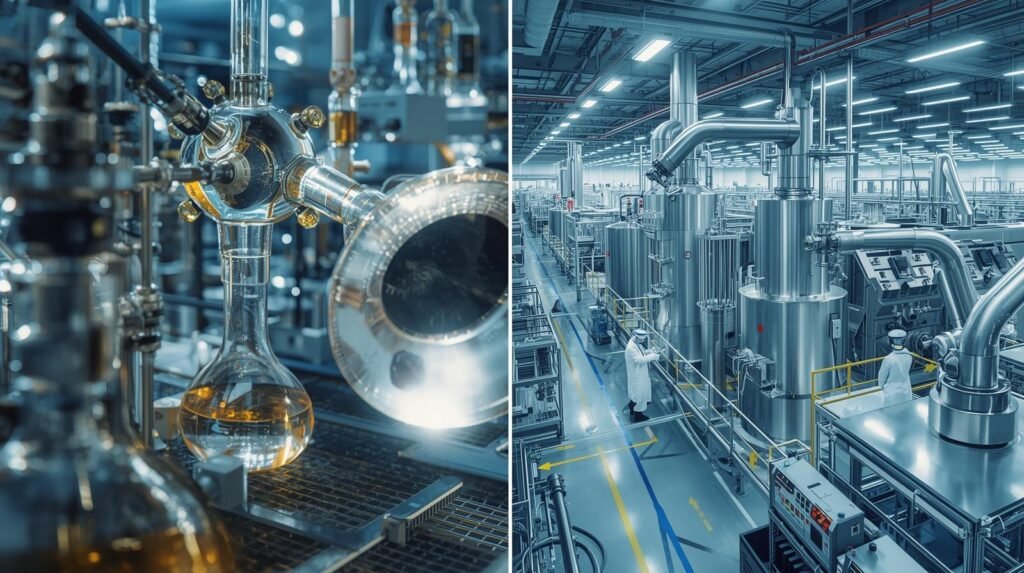
The global peptide therapeutics market, projected to reach $75 billion by 2028, is experiencing unprecedented pricing volatility as contract manufacturing organizations (CMOs) navigate complex supply chain disruptions, raw material inflation, and intensifying competition. With peptide API manufacturing costs increasing by 25-40% over the past two years and CMO capacity utilization rates exceeding 85%, pharmaceutical companies face critical decisions about sourcing strategies that balance cost, quality, and supply security. This comprehensive analysis examines the fundamental forces reshaping peptide pricing dynamics, from raw material scarcity and regulatory pressures to technological innovations and competitive realignments, providing strategic insights for manufacturers, developers, and investors navigating this rapidly evolving landscape.
Introduction to Peptide Pricing Dynamics
The peptide therapeutics market has transformed from a niche segment to a mainstream pharmaceutical category, with pricing structures reflecting the complex interplay of scientific advancement, manufacturing complexity, and market forces. Understanding these dynamics is essential for stakeholders across the value chain.
Current Market Overview and Growth Trajectory
The peptide market demonstrates robust growth with significant pricing implications:
- Market Size: $52.3 billion in 2024, growing at 12.4% CAGR through 2028.
- Therapeutic Expansion: Diabetes, obesity, oncology, and cardiovascular applications driving demand.
- Manufacturing Concentration: 70% of capacity controlled by top 15 CMOs globally.
- Price Evolution: Average peptide API prices increasing 8-12% annually despite volume growth.
Factors Influencing Peptide Pricing Structures
Multiple variables contribute to the complex pricing landscape for peptide therapeutics, requiring sophisticated analysis and strategic planning.
Raw Material Costs and Availability
Key raw material factors impacting peptide pricing:
- Amino Acid Pricing: Fmoc-protected amino acids experiencing 15-25% cost increases.
- Solvent Availability: DMF, DCM, and acetonitrile supply chain disruptions adding 8-15% to costs.
- Resin Shortages: Solid-phase synthesis resin costs increasing 20-30% due to supply constraints.
- Energy Costs: Manufacturing energy expenses rising 25-40% impacting operational costs.
Manufacturing Complexity and Technology Requirements
Technical factors driving pricing differentials:
- Synthesis Method: Solid-phase vs. liquid-phase synthesis cost variations of 30-50%.
- Peptide Length: Cost increases of 15-25% for each additional amino acid beyond 30 residues.
- Modification Complexity: PEGylation, cyclization, and other modifications adding 20-40% to costs.
- Purification Requirements: HPLC purification complexity contributing 15-30% to total costs.
Regulatory Compliance and Quality Assurance
Quality and regulatory factors influencing pricing:
- GMP Compliance: cGMP requirements adding 20-35% to manufacturing costs.
- Documentation and Validation: Regulatory documentation contributing 10-20% to overall expenses.
- Audit and Inspection Costs: Quality system maintenance adding 5-15% to operational overhead.
- Stability Testing: Comprehensive stability programs accounting for 8-12% of development costs.
“The peptide pricing landscape has fundamentally shifted from a cost-plus model to a value-based framework where manufacturers must justify prices through demonstrated clinical outcomes and manufacturing excellence. Companies that master this transition will capture disproportionate value in the evolving market.” — Dr. Michael Chen, Pricing Strategy Director, Global Pharma Consultancy.
Contract Manufacturing Rate Structures and Analysis
CMO pricing models have evolved to reflect the specialized nature of peptide manufacturing and the unique requirements of different therapeutic categories.
CMO Pricing Models by Service Type
Diverse pricing approaches across service categories:
| Service Category | Pricing Model | Typical Rate Range | Key Cost Drivers |
|---|---|---|---|
| Process Development | Fixed fee or time/materials | 250,000 – 1.5 million | Peptide complexity, timeline urgency |
| Clinical Manufacturing | Per gram with volume tiers | 5,000 – 25,000/g | Quantity, purity requirements |
| Commercial Manufacturing | Volume-based with minimums | 1,000 – 8,000/g | Annual volume, contract term |
| Analytical Services | Per test or package pricing | 50,000 – 300,000 annually | Method complexity, frequency |
Geographic Variations in Manufacturing Rates
Significant regional differences in CMO pricing:
- North America: Premium pricing with rates 20-30% higher than global average.
- European Union: Moderate pricing with strong quality focus and regulatory alignment.
- Asia-Pacific: Competitive pricing but increasing quality standards and costs.
- Emerging Markets: Lower costs but higher risk and regulatory challenges.
Market Pressures Reshaping Peptide Economics
External forces are creating both challenges and opportunities in peptide pricing and manufacturing strategies.
Supply Chain Disruptions and Cost Inflation
Current supply chain challenges impacting pricing:
- Raw Material Shortages: 35% of manufacturers report supply disruptions affecting production.
- Logistics Costs: Shipping and transportation expenses increasing 25-50%.
- Lead Time Extensions: Material delivery times extending from 4-6 weeks to 12-16 weeks.
- Inventory Costs: Safety stock requirements increasing working capital needs by 20-35%.
Competitive Pressures and Market Consolidation
Competitive dynamics influencing pricing strategies:
- CMO Consolidation: Top 5 CMOs increasing market share from 45% to 60% in five years.
- Price Competition: Aggressive bidding reducing margins by 8-15% in competitive tenders.
- Capacity Constraints: 85%+ utilization rates enabling price increases of 10-20%.
- New Entrants: Specialty CMOs focusing on niche peptides with premium pricing.
Strategic Pricing Approaches for Peptide Manufacturers
Successful peptide pricing requires sophisticated strategies that balance cost recovery, value demonstration, and market positioning.
Value-Based Pricing Models
Advanced pricing approaches capturing therapeutic value:
- Outcome-Based Pricing: Linking prices to demonstrated clinical outcomes and patient benefits.
- Risk-Sharing Models: Aligning pricing with development risk and regulatory success.
- Tiered Pricing Structures: Differentiated pricing based on volume and partnership level.
- Lifecycle Pricing: Strategic pricing across development, launch, and maturity phases.
Cost Optimization Strategies
Approaches to managing and reducing manufacturing costs:
- Process Intensification: Continuous manufacturing reducing costs by 25-40%.
- Technology Adoption: Automation and AI improving efficiency by 15-30%.
- Supply Chain Optimization: Strategic sourcing reducing material costs by 10-25%.
- Quality by Design: Reducing variability and improving yields by 8-20%.
Future Trends in Peptide Pricing and Manufacturing Economics
The peptide pricing landscape continues to evolve with emerging technologies, regulatory changes, and market developments.
Technology Impact on Future Pricing
Innovations shaping future cost structures:
- Continuous Manufacturing: Potential 30-50% cost reduction through process efficiency.
- Artificial Intelligence: Predictive optimization reducing development costs by 25-40%.
- Green Chemistry: Sustainable processes lowering environmental costs and improving efficiency.
- Digital Twins: Virtual modeling reducing scale-up costs and time by 40-60%.
Regulatory and Market Evolution
External factors influencing future pricing dynamics:
- Generic Competition: Patent expirations enabling 40-60% price reductions.
- Regulatory Harmonization: Streamlined requirements reducing compliance costs by 15-25%.
- Value-Based Healthcare: Increasing focus on cost-effectiveness and outcomes-based reimbursement.
- Personalized Medicine: Smaller batch sizes requiring flexible pricing models.
FAQs: Peptide Pricing Dynamics and Contract Manufacturing
Q: What are the typical cost components in peptide contract manufacturing, and how do they vary by peptide complexity?
A: Peptide manufacturing costs typically include raw materials (30-40% of total cost), labor and overhead (25-35%), quality control and assurance (15-20%), and profit margin (10-15%). Complexity significantly impacts these proportions: for simple peptides (<20 amino acids), raw materials may constitute 40-50% of costs, while for complex peptides (>40 amino acids with modifications), manufacturing complexity can increase labor and QC costs to 50-60% of total expenses. Additional factors include purification requirements (HPLC vs. standard methods can double costs), regulatory requirements (GMP compliance adds 20-35%), and scale (commercial scale reduces per-unit costs by 60-80% compared to clinical scale).
Q: How can pharmaceutical companies negotiate favorable contract manufacturing rates for peptide APIs?
A: Successful negotiation strategies include: conducting thorough competitive bids among multiple CMOs, offering multi-year commitments in exchange for volume-based discounts, sharing development risks through risk-reward models, leveraging long-term partnership opportunities rather than transactional relationships, and understanding the CMO’s cost structure to identify win-win opportunities. Companies should also consider value beyond price, including quality systems, regulatory track record, and technological capabilities. Typical negotiation outcomes can achieve 10-25% cost reductions through strategic partnerships, with additional savings possible through process optimization collaborations and volume guarantees.
Q: What impact will patent expirations have on peptide pricing in the next 3-5 years?
A: Patent expirations between 2025-2028 will significantly impact peptide pricing, particularly for blockbuster GLP-1 analogs and other major therapeutic categories. We expect initial price reductions of 40-60% for generic versions within the first year post-patent expiration, with further erosion to 70-80% below originator prices within 3-5 years. However, complex peptides may maintain higher price points due to manufacturing challenges, with generics priced 30-50% below originators. The overall market impact will include increased volume growth (25-40% expansion due to improved access) and potential innovation in next-generation products from originator companies seeking to maintain premium pricing.
Core Takeaways
- Pricing Complexity: Peptide pricing reflects multifaceted factors including manufacturing complexity, raw material costs, and regulatory requirements.
- Market Evolution: Contract manufacturing rates are evolving toward value-based models and strategic partnerships.
- Strategic Imperative: Understanding pricing dynamics is essential for successful product development and commercialization.
- Future Focus: Technology innovation and regulatory changes will continue to reshape peptide economics.
- Competitive Advantage: Companies that master pricing strategy will achieve sustainable market leadership.
Conclusion: Navigating the Evolving Peptide Pricing Landscape
The peptide pricing landscape represents a dynamic interplay of scientific advancement, manufacturing innovation, and market forces. As the market continues to grow and evolve, stakeholders must develop sophisticated pricing strategies that balance cost recovery, value demonstration, and competitive positioning. The companies that successfully navigate this complex landscape will be those that embrace transparency, collaboration, and innovation in their pricing approaches.
Looking ahead, peptide pricing will increasingly reflect the value these molecules deliver to patients and healthcare systems, with greater emphasis on outcomes-based models and risk-sharing arrangements. Manufacturers that invest in process efficiency, quality excellence, and strategic partnerships will be well-positioned to succeed in this evolving market, delivering sustainable value to all stakeholders while advancing the development of innovative peptide therapeutics for patients worldwide.
Disclaimer:
This article contains information, data, and references that have been sourced from various publicly available resources on the internet. The purpose of this article is to provide educational and informational content. All trademarks, registered trademarks, product names, company names, or logos mentioned within this article are the property of their respective owners. The use of these names and logos is for identification purposes only and does not imply any endorsement or affiliation with the original holders of such marks. The author and publisher have made every effort to ensure the accuracy and reliability of the information provided. However, no warranty or guarantee is given that the information is correct, complete, or up-to-date. The views expressed in this article are those of the author and do not necessarily reflect the views of any third-party sources cited.





